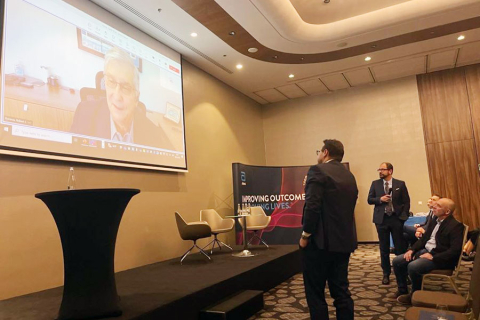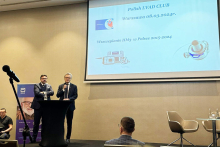Polish LVAD Club
The first Polish LVAD Club symposium was held on Friday, March 8, at Airport Hotel in Warsaw, upon the initiative of professor Mariusz Kuśmierczyk, Head of WUM Medical University of Warsaw Clinical Center Cardiothoracic Surgery and Transplantology Clinical Department. The meeting was officially opened by Zbigniew Gaciong, Rector of WUM Medical University of Warsaw. Among the attendees, there were representatives of the 7 sites in Poland that use LVAD heart assisting methods. The keynote speaker was professor Robert Kormos of Pittsburgh, Untied States, a world guru and pioneer of mechanical blood circulation assisting worldwide. It was an interdisciplinary event, attended by multiple physicians, cardiologists, cardiac surgeons, psychologists, circulatory assist coordinators - Poland’s capital was visited by approximately 70 people altogether.
– We have to demonstrate, here in Poland, that cardiac assist systems are really helpful for severe heart failure patients. After this kind of operations, the patients are not restricted to their house and their TV set, they can do anything they want, and the most important thing is that they can enjoy their lives – professor Kuśmierczyk said at the event.
The meeting included a debate on financing treatment, possible complications, challenges, patient care and preparing the patient to function with the system in a home environment.
An assist device is available off the shelf, unlike a new heart
Heart transplantation is still considered the golden standard of proceeding with end-stage heart failure patients, but unfortunately there is a shortage of hearts for transplants. With the advancement of medicine, heart function can be assisted mechanically, particularly in the long-term perspective. A special Heart Mate 3 pump guarantees that the heart will keep working even for years. It is a left ventricular assist device and, as a target treatment, it may be an alternative for severe heart failure patients who are not eligible for a transplant, or who are eligible but waiting for the organ.
– The line of patients working for a heart transplant is still significantly longer than the number of donors. Hence, mechanical circulatory assist devices are an opportunity for patients which cannot be wasted – professor Zbigniew Gaciong, Rector of WUM, said at the symposium.
How the device works
The assist device is battery powered from outside, implanted through the abdominal integuments from where the cables exit. The cable exit site needs special care to prevent infection. The patient, their family members and physicians are properly trained and prepared to deliver such care. The patient can freely move and do most everyday things, so that the quality of life is satisfactory.
100 such assist devices were implanted in Poland last year
Professor Mariusz Kuśmierczyk first implanted a new generation HM3 device in Poland on December 15, 2015:
– The patient lived for 7 years with the device and only then underwent a heart transplant, which shows that this option lets patients survive and have a more comfortable life with an advanced heart failure – professor Kuśmierczyk comments.
WUM Medical University of Warsaw is a new site that offers this opportunity to severe heart failure patients.
– We recognize this method as a very prospective one – professor Kuśmierczyk says. – A patient who has had the device implanted is in continuous communication with the hospital, their health status is monitored all the time by a computer system that collects all the patient’s data. Moreover, a team of coordinators is on 24/7 watch on the phone, ready to help the patient in any circumstances. The device implant offers 55% survival rate for a 5-year period, while for conservative treatments, 2-year survival rate is at ca. 10%. These numbers speak for themselves.




